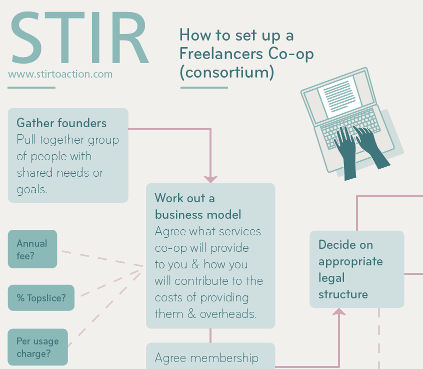or ‘How to make God laugh’ – Woody Allen
Participative strategic planning is a means for engaging all members in planning the future direction of the co-operative business. In this way we can avoid conflicts caused by lack of information or misunderstandings about goals, aims or ‘how we do things here’. It’s strategic planning done in a co-operative, collaborative and participative way.
Strategic planning is a way of coping with change and planning for the future. It aims to accomplish three tasks:
- to explore and clarify direction for the medium to long term, identifying desired outcomes
- to select broad strategies that will enable the co-operative to achieve those outcomes
- to identify ways to measure progress
Co-operatives use the process to build member commitment by involving them in the creation of the plan, but how you go about it will depend on your co-op’s structure, how long you have been established, your economic sector and the complexity of your business
One approach is to hold an annual Away Day aiming to integrate new members, facilitate interaction between different teams, and discuss co-operative performance and future plans.
It’s helpful to clarify the language of strategic planning before you start – so you can at least agree a common understanding. For example:
Strategic work is about where you want to go, it’s about the long term and involves setting aims and objectives, goals and outcomes – or draining the swamp?
Tactical is about how you’re going to get there, agreeing a route or a map. It’s more reactive and perhaps opportunistic, involving setting milestones towards the achievement of goals and organising timetables, action plans and rotas.
Operational is about the journey, it focuses on the short term day to day outputs, crisis management and fire-fighting – or fighting the crocodiles?
So make sure you look up from time to time from fighting the crocodiles to see if you can find time to drain the swamp!
|
Strategic
‘Drain the swamp’
|
Tactical
|
Operational
‘Fight the crocodiles’
|
|
• Goals
• Aims and objectives
• Long term
• Outcomes
Where you want to go
|
• Milestones, KPIs
• Timetables, rotas
• Reactive, opportunistic
• Map, route
How you’re going to get there
|
• Day to day
• Crisis management
• Short term
• Outputs
The journey
|
Key questions for strategic planning:
- are your co-operative vision and values clear, agreed and owned?
- how well do you understand the market? Is it growing, shrinking, or flat-lining?
- how well-informed are you about suppliers & competitors?
- how fit is the co-operative organisation? Purring along nicely or bit bumpy?
- are members ready to act?
Strategic planning – beyond the systems approach
Traditional management tools are inadequate for worker co-ops, since they are based on ‘systems’ thinking, which assumes controllers and controlled. Instead of thinking about organisations as machines, controlled by managers pulling levers, Ralph Stacey of the University of Hertfordshire talks instead about ‘complex responsive processes’ with high participation and constant change. He describes organisations (including co-operatives) as processes of human relationships and communication where people create and are created by the organisation and where no one can plan or control this interplay.
Here are some tools and techniques based on this understanding of business as a series of interactions and conversations between people at all levels of the business.
Tools and techniques for participative strategic planning
Active Business Planning uses project management techniques, researching information on size and characteristics of the market, acceptable pricing, level of sales, etc. simultaneously and using the knowledge gained in one area to amend others. Active business planning uses a timeline (GANNT) chart to identify the dates of starting and ending each business planning action.
Agile is an approach to business planning based on techniques typically used in software development as a response to unpredictability. In contrast to traditional project management, with its sequence of: define aims – market research – product development – market strategy – implement strategy, the Agile approach is iterative and incremental, with all activities blending into several iterations and adapting to discovered realities at fixed intervals.
RISK ANALYSIS is a slightly different approach, involving looking at all the risks to your co-operative business and quantifying them in a table according to:
-
- How likely it is to occur, or probability
- What impact would it have on the business if it did occur?
You then multiply (1.) by (2.) to get a rough and ready way to prioritise action. The final two columns in the table encourage you to think about how to prevent the risk from happening and if it does happen anyway, how to minimise the impact on your business.
|
RISK
|
PROBABILITY
1-5
|
IMPACT
1-5
|
RISK SCORE
|
MITIGATION
How to stop it happening
|
CONTINGENCY
If it happens anyway, how to minimise impact
|
|
|
|
|
|
|
|
|
|
|
|
|
|
|
|
|
|
|
Appreciative Inquiry is a more positive, ‘glass half full’ approach. It involves four stages:
- DISCOVERY Focus on what’s working, build on success. What are our strengths? What do we enjoy? What do we want to do more of?
- DREAM Use our strengths and what we want to do to create a shared vision of the future – what might be?
- DESIGN Co-create a design to make it happen, based on our values & principles
- DELIVERY What will be? Sustain the vision through empowering people, learning, adjusting, improvising

